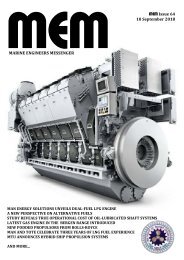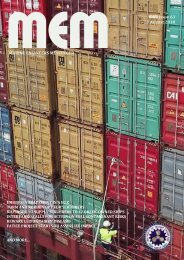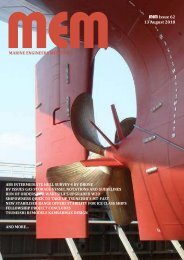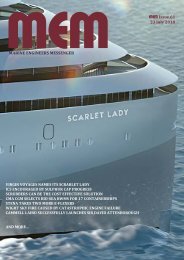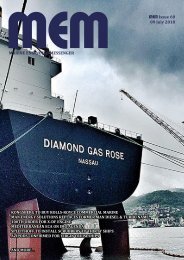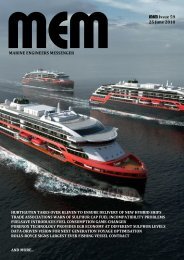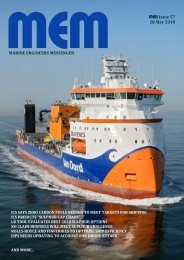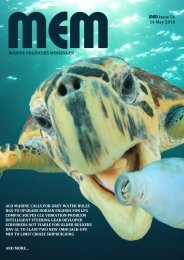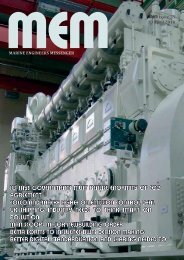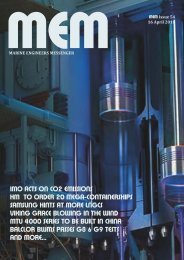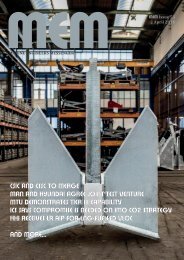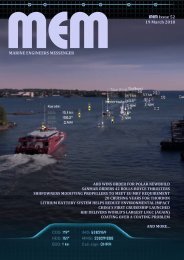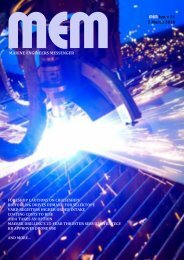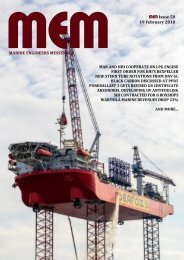MEM38
Marine Engineers Messenger Volume 2 Issue 38
Marine Engineers Messenger Volume 2 Issue 38
You also want an ePaper? Increase the reach of your titles
YUMPU automatically turns print PDFs into web optimized ePapers that Google loves.
MEM<br />
MEM<br />
MARINE ENGINEERS MESSENGER<br />
Issue 38<br />
28 August 2017<br />
FUSION ENERGY BREAKTHROUGH<br />
PRELUDE ENTERS LR CLASS<br />
WÄRTSILÄ TO SERVICE ABB TURBOCHARGERS<br />
USCG TYPE APPROVAL TESTS COMPLETE FOR EVOQUA SEACURE<br />
SHIPPING “WAKES UP” TO ENERGY STORAGE POTENTIAL<br />
SEAVIEW FLOATS OUT<br />
MAN AND AKA WIN RUSSIAN ORDER<br />
MTU ENGINES POWER 90TBP TUGS
MEM<br />
MARINE ENGINEERS MESSENGER<br />
MEM Issue 38<br />
28 August 2017<br />
Telegraph<br />
The California State Lands Commission has approved Article 4.8 of its Biofouling Management Regulations,<br />
aimed at minimising the transfer of non-indigenous species (NIS) from vessels arriving at California Ports.<br />
The biofouling management regulations have also been approved by California’s Office of Administrative<br />
Law and are now set to become effective on October 1, 2017.<br />
In a letter to shipping agents and other parties, dated 15 August, Nicole Dobroski, Assistant Chief, Marine<br />
Environmental Protection Division of the CSLC, explained that the provisions:<br />
• Repeal the reporting requirements for the Hull Husbandry Reporting Form, the Ballast Water<br />
Treatment Supplemental Reporting Form and the Ballast Water Treatment Annual Reporting Form;<br />
• Adopt the Marine Invasive Species Program Annual Vessel Reporting Form.<br />
The remaining requirements will be applicable after a vessel’s first regularly scheduled dry dock, after<br />
January 1, 2018, or upon delivery on or after January 1, 2018, including requirements for:<br />
• Developing and maintaining a Biofouling Management Plan;<br />
• Developing and maintaining a Biofouling Record Book;<br />
• Mandatory biofouling management of the vessel’s wetted surfaces;<br />
• Mandatory biofouling management for vessels that undergo an extended residency period (i.e., remain<br />
in the same location for 45 or more days);<br />
The California State Lands Commission anticipates many questions about the upcoming implementation of<br />
the biofouling management regulations and is developing a series of Customer Service meetings in northern<br />
and southern California and an internet-based webinar to provide answers to any questions that may arise<br />
from implementation.<br />
There is increasing concern about the transfer of NIS by ships’ hulls. Last month a study was published by<br />
Tel Aviv University’s School of Zoology highlighting that biofouling on ships’ hulls is contributing to the spread<br />
of invasive aquatic species in the Mediterranean Sea. According to the research half the ships passing along the<br />
Mediterranean coast of Israel are carrying invasive ascidians, presenting a global threat to ecosystems around<br />
the world.<br />
TAU’s Dr. Noa Shenkar, who led the research, said: “These organisms are passing through the Suez Canal,<br />
latching onto ropes and the bottom of the ship. They're filter feeders, so they cover and clog every surface they<br />
latch onto, creating a lot of drag for the ship and damaging marine biodiversity in their new environments.<br />
They're a major threat to our coasts and are very costly to shipowners."<br />
Among the wide occurrence of non-indigenous ascidians (NIA), TAU researchers discovered a Caribbean<br />
species new to the region. The findings, state the authors of the report, “strongly support the hypothesis that<br />
marine vessels constitute a substantial vector for the introduction and dispersal of NIAs”.<br />
MARINE ENGINEERS MESSENGER<br />
SHIP TECHNOLOGY NEWS TO 8544 DECISION MAKERS<br />
EVERY TWO WEEKS<br />
Click here for more information about our favourable advertising rates or<br />
email: mem@seabornecomms.com<br />
2
ENERGY<br />
FUSION A STEP CLOSER<br />
In the quest for fusion energy, scientists have spent decades experimenting with ways to make plasma fuel hot<br />
and dense enough to generate significant fusion power. Researchers from the Massachusetts Institute of<br />
Technology (MIT), however, may have found a breakthrough in what is deemed the “holy grail” of energy<br />
research.<br />
Researchers focused their attention on using radio-frequency heating in magnetic confinement fusion<br />
experiments, like the Alcator C-Mod tokamak, one of several types of magnetic confinement devices being<br />
developed to contain the hot plasma needed for producing controlled thermonuclear fusion power.<br />
Using data from these experiments, researchers at MIT’s Plasma Science and Fusion Centre (PSFC), along<br />
with colleagues in Belgium and the UK, created a new method of heating fusion plasmas in tokamaks.<br />
The new method has resulted in raising trace amounts of ions to megaelectronvolt (MeV) energies — an<br />
order of magnitude greater than previously achieved.<br />
“These higher energy ranges are in the same range as activated fusion products,” PSFC research scientist<br />
John C. Wright explained. “To be able to create such energetic ions in a non-activated device — not doing a<br />
huge amount of fusion — is beneficial, because we can study how ions with energies comparable to fusion<br />
reaction products behave, how well they would be confined.”<br />
The new approach, recently detailed in the journal Nature Physics, uses a fuel composed of three ion species:<br />
hydrogen, deuterium, and trace amounts of helium-3. Typically, plasma used for fusion research in the<br />
laboratory would be composed of two ion species, deuterium and hydrogen or deuterium and He-3, with<br />
deuterium dominating the mixture by up to 95 per cent.<br />
Researchers focus energy on the minority species, which heats up to much higher energies owing to its<br />
smaller fraction of the total density. In the new three-species scheme, all the RF energy is absorbed by just a<br />
trace amount of He-3 and the ion energy is boosted even more — to the range of activated fusion products.<br />
Wright was inspired to pursue this research after attending a lecture in 2015 on this scenario by Yevgen<br />
Kazakov, a researcher at the Laboratory for Plasma Physics in Brussels, Belgium, and the lead author of<br />
the Nature Physics article. Wright suggested that MIT test these ideas using the Alcator C-Mod, with Kazakov<br />
and his colleague Jef Ongena collaborating from Brussels.<br />
The successful results provide “proof of principle” enough to get scientists at the UK’s Joint European Torus<br />
(JET), Europe’s largest fusion device, interested in reproducing the results. Like JET, C-Mod operated at<br />
magnetic field strength and plasma pressure comparable to what would be needed in a future fusion-capable<br />
device.<br />
“The JET folks had really good energetic particle diagnostics, so they could directly measure these high<br />
energy ions and verify that they were indeed there,” said Wright. “The fact that we had a basic theory realised<br />
on two different devices on two continents came together to produce a strong paper.”<br />
4
TURBOCHARGING<br />
WÄRTSILÄ TO SERVICE ABB TURBOCHARGERS<br />
Wärtsilä Corporation and ABB<br />
Turbocharging have agreed to expand<br />
their cooperation, with ABB granting<br />
Wärtsilä Authorised Service Provider<br />
status for the maintenance of its<br />
turbochargers installed on Wärtsilä<br />
four-stroke engines.<br />
The six-year service agreement<br />
covers standard maintenance and<br />
performance optimisation and<br />
represents an extension to the longterm<br />
cooperation agreement both<br />
parties inked in 2005.<br />
To ensure smooth processes and<br />
effective management of installation<br />
performance, Wärtsilä and ABB will<br />
share specific service data and<br />
maintenance documents. This also<br />
enables the inclusion of ABB turbochargers in the Wärtsilä Online Services offering. The Authorised Service<br />
Provider status for standard maintenance includes disassembly, exchange of parts, balancing and reassembly of<br />
ABB turbochargers installed with Wärtsilä four-stroke engines.<br />
"Being able to look at the whole installation increases its availability and efficiency, optimising service speed<br />
and agility. Customers can reduce their operational risk, ensure optimal tuning and save time by being able to<br />
overhaul their ABB turbocharger at the same time as the engine. Wärtsilä's aim is to expand its leadership as a<br />
global provider of quality services also to turbochargers. Thanks to this agreement, we are now able to serve<br />
our customers even better by offering them ABB turbocharger services coupled with our engine knowhow<br />
across 25 locations," says Tomas Hakala, Vice President, four-stroke Engine Services at Wärtsilä Services.<br />
Herbert Müller, Head of Service, ABB Turbocharging, adds: "This agreement is a logical expansion of the<br />
cooperation established for new engine developments, where we jointly aim to push the boundaries of engine<br />
performance to new levels. With this new service agreement, ABB aims to foster our leading position in the<br />
field of advanced upgrade solutions during the lifecycle to improve performance of our customers in their<br />
businesses.”<br />
The agreement will result in 25 authorised Wärtsilä turbocharger workshops with an expanded service and<br />
maintenance offering. This is in addition to the 110 existing ABB Turbocharging Service Stations around the<br />
globe. Customers will benefit from this expansion of authorised resources available to keep their equipment up<br />
and running, and performing well.<br />
PRIME MOVERS<br />
MAN AND AKA WIN RUSSIAN ORDER<br />
MAN Diesel & Turbo and partner Aspin Kemp and Associates (AKA) have secured a contract to provide dieselelectric<br />
propulsion package for a multi-purpose supply vessel under construction for a federal Russian agency.<br />
The contract marks the first successful collaboration between the two companies since MAN Diesel & Turbo<br />
bought a 40% share in AKA – the Canadian electric-and-hybrid-systems company – in June 2017.<br />
Four MAN 7L21/31 gensets, including alternators, will be delivered to an undisclosed shipyard<br />
in St Petersburg. AKA’s scope of supply includes a 690V main switchboard, 690V-to-400V<br />
transformers, electric propulsion motors and frequency converters, and drive<br />
control and power-management systems.<br />
The vessel is scheduled for a March 2018<br />
delivery.<br />
Wayne Jones, Chief Sales Officer – MAN<br />
Diesel & Turbo, said: “This specialist vessel,<br />
with its unique operational demands,<br />
showcases MAN Diesel & Turbo’s competence<br />
as a solution provider and the broader<br />
capability we now possess with AKA’s<br />
energy-management expertise.<br />
5
Encouragingly for our new partnership, the previous vessel in this series was equipped with an identical<br />
propulsion package, but from a different supplier.”<br />
AKA’s CEO, Jason Aspin, said: “We are excited to deliver on this first order together with our new partner,<br />
MAN Diesel & Turbo. Our expertise in energy management, and electrical-system integration, combined with<br />
MAN’s vast experience in power-train solutions, allows us to deliver a completely integrated power and<br />
propulsion system for this vessel, making it a WIN-WIN-WIN between our partnership and this client”.<br />
The partnership with AKA represents part of MAN Diesel & Turbo’s strategic development programme,<br />
"Basecamp 3000+", launched in 2016 when the company announced strategic acquisitions and partnerships to<br />
expand its product range with respect to the global trends of decarbonisation and digitisation.<br />
WÄRTSILÄ HYBRID FIRST FOR FISHERIES<br />
A new fish processing and transportation vessel building at Spain’s Balenciaga shipyard for Norwegian owner<br />
Hav Line, will be powered by a Wärtsilä arrangement based around a 10-cylinder W31 prime mover.<br />
The low-emission vessel, a Wärtsilä design, features a hybrid propulsion solution that makes use of a<br />
battery-powered power take-in/ power take-off system. By absorbing most of the engine's load fluctuations<br />
and vessel load variations through the batteries, the engines can be operated close to its optimum design<br />
point, thereby providing the highest level of efficiency.<br />
When the vessel is delivered next summer, it will be the first fisheries vessel to adopt such a power<br />
arrangement.<br />
"The fish farming industry, like other marine industry sectors, is seeking better ship designs and greater<br />
efficiencies that reduce overall operating costs and lessen the environmental impact. Wärtsilä is proud to have<br />
been selected for this project that introduces the world's first hybrid propulsion system for this kind of vessel,"<br />
says Riku-Pekka Hägg, Vice President, Wärtsilä Ship Design.<br />
Wärtsilä has also been contracted to supply auxiliary engines, gears, sterntube seals and bearings, CP<br />
propellers and remote control and automation systems.<br />
Following its introduction in 2015, the Wärtsilä 31 was recognized the world's most efficient four-stroke<br />
diesel engine by Guinness World Records.<br />
MTU ENGINES POWER 90TBP TUGS<br />
Rolls-Royce and Turkey’s Sanmar Shipyards have signed a contract for the delivery of eight MTU Series 4000<br />
engines for four new terminal tugs, including an option for a further four engines.<br />
The tugs will be fitted with two 16V 4000 M73L MTU engines, each delivering an output of 2,700kW at<br />
1,850rpm.<br />
Ali Gürün, Projects Director of Sanmar Shipyards, commented: “We were impressed by MTU’s technical<br />
support, the service and the reliability of the MTU engines, which is why we will also be equipping our new<br />
Robert Allen/ Rastar 2900sx tugs with MTU engines.”<br />
Knut Müller, Head of the Marine and Government Business Division at MTU, said: “This is the first time<br />
high-speed engines are being used to power harbour tugs in this power class. To date, it has only been possible<br />
to use medium-speed engines for harbour tugs with a bollard pull of over 85t. We are delighted that we have<br />
now been successful in entering this market.”<br />
The speed of the engine has been reduced to 1850rpm specifically for this application in order to provide<br />
the Shipyards with direct control of the propeller without an intermediate gearbox.<br />
6
The Robert Allen/ Rastar 2900 SX terminal tugs, with a length of just under<br />
30m, will be added to the fleet operated by the Danish towage company Svitzer<br />
as of 2018.<br />
The tugs are to be used in the Tanger-Med Port in Morocco, the<br />
operators of which have now signed a 20-year contract with Svitzer for<br />
terminal towage services. The port is strategically located on the<br />
north-west coast of Africa, close to the entrance to the<br />
Mediterranean on the Strait of Gibraltar, and is the second<br />
busiest container port on the African continent.<br />
MTU and Sanmar have signed an additional<br />
contract for the delivery of four 16V 4000<br />
M63 engines, each delivering 2000kW of<br />
power for two tugs with a 70t bollard pull.<br />
These new contracts now bring the number of<br />
tugs built by Sanmar to date and fitted with MTU<br />
engines to 16. Half of the tug types currently<br />
available from Sanmar Shipyards are fitted with MTU<br />
engines.<br />
VOLVO PENTA’S MOST POWERFUL ENGINE<br />
An exciting milestone has been reached for Volvo Penta, with its new 1000hp 13l engine, especially for owners<br />
of large yachts, who will now be able to benefit from better propulsion performance.<br />
The new D13-1000 sees Volvo Penta move into the 1000hp marine leisure engine market for the first time,<br />
and provides higher performance, greater durability and more comfort than ever before.<br />
The inboard engine and its equivalent from Volvo Penta’s Inboard Performance System (IPS) range – the<br />
D13-IPS1350 – have been designed for the benefit of customers operating yachts of up to 120ft.<br />
“This is hugely exciting for us to create our most powerful engine yet,” says Johan Wästeräng, vice president<br />
for product management in the marine leisure segment at Volvo Penta. “It’s truly a landmark product for our<br />
marine range, and really gives us a bigger step into the large yacht market. We’ve spent a long time talking to<br />
customers about what they want, and refining our engine and IPS designs, so that we can offer unique<br />
experiences with exceptional products that are ideal for world-class vessels.”<br />
As a mark of its commitment to the marine leisure industry, Volvo Penta has carried out a major redesign of<br />
the 13-litre engine model and drivetrain in order to offer an outstanding new product. High-end yacht<br />
customers will be able to reap the benefits, as features such as new pistons, highly efficient injectors and<br />
improved cooling systems, combine to produce 11 per cent more power than on previous engines.<br />
The optimised power-to-weight ratio and excellent low-end torque of the D13-1000 provide incredible<br />
power on demand. With this new engine, Volvo Penta is giving premium yacht owners the possibility to go<br />
further and faster than ever before.<br />
Volvo Penta’s D13-IPS1350 is an integrated package that matches the new D13 engine with an upgraded IPS<br />
pod drive.<br />
Upgrades to the IPS pod drive have been made to match the new engine. The D13-IPS1350 package is<br />
available in twin, triple or quadruple installation; the latter of these provides power to the equivalent of<br />
5400hp. Improved features on the new IPS drive can also be fitted on existing IPS units.<br />
“The IPS drive has been upgraded so that it can handle the extra<br />
performance from the new D13 engine,” says Björn Rönnvall,<br />
product manager for the marine leisure segment at Volvo Penta.<br />
“We have found that there is a demand for greater durability<br />
with bigger yachts as the captain has to cruise to wherever<br />
the owner wants it to be, so the usage is higher. Increased<br />
low-end torque gives the vessel greater manoeuvrability<br />
at low speeds, and with the compact configuration this<br />
means there is more room on board for the luxuries that<br />
high end yacht owners want. IPS gives versatility and more<br />
freedom of design and performance – it really is the<br />
ultimate choice for large yachts.”<br />
“With 36 per cent better fuel economy this means that our<br />
IPS package has a much greater cruising range than a typical inboard<br />
engine,” says Rönnvall. “To put that into context, customers would be able to<br />
cruise from Cannes to the Balearic Islands without having to refuel in Spain, or<br />
from Miami to the Bahamas and back again on one tank of fuel.”<br />
7
MARINE COATINGS<br />
ECOSPEED DECISION VALIDATED BY ERNEST SHACKLETON<br />
British Antarctic Survey’s decision to apply the Ecospeed hard coating to the hull of its new polar research<br />
ship RRS Sir David Attenborough has been<br />
validated after the recent drydocking of sister<br />
vessel RRS Ernest Shackleton.<br />
The 80m long vessel, coated with Ecospeed in<br />
2009, drydocked last month at the Orskov<br />
shipyard, in Frederikshavn, Denmark, where the<br />
hull was found to be in “very good condition”.<br />
BAS Superintendent Andrew Webb, said:<br />
“Shackleton’s hull condition is the best I have seen<br />
after typical ice year operations. We tend to<br />
account for touch up coats every other year to<br />
areas impacted by the ice, but this year we needed<br />
to repair even less surface area than expected,<br />
despite the vessel encountering heavy Antarctic<br />
ice.”<br />
The Orskov yard had to touch up areas in the<br />
bow and rudder areas. A touch up coat was last<br />
applied in 2015. Only remedial coats are required<br />
as Ecospeed is a one-coat system and does not<br />
need to be removed or reapplied.<br />
The durability of the coating and the ease with<br />
which repairs can be effected were the reasons<br />
why BAS/NERC selected Ecospeed for the<br />
newbuild RRS Sir David Attenborough.<br />
“The shipyard initially wanted to apply its<br />
preferred supplier’s coating system, but based on<br />
our experience of this coating on the James Clark<br />
Ross and Ernest Shackleton we wanted Ecospeed.<br />
“We already had this system on the entire hulls<br />
below the water line of both research vessels and<br />
found it much easier to repair: it doesn’t need to be applied under such strict environmental conditions or<br />
require the hire of any specialist application equipment.”<br />
During 2013/14 BAS replaced the competitor system with Ecospeed across the entire hull of James Clark<br />
Ross, which is scheduled to drydock this month (August).<br />
Subsea Industries’ hull protection system will be applied to the hull of RRS Sir David Attenborough, the polar<br />
research ship under construction at the Cammell Laird shipyard in Birkenhead, Liverpool, UK. The 15,000gt<br />
research vessel, scheduled for operational duties in 2019, will be one of the most advanced polar research<br />
vessels in the world.<br />
RRS Ernest Shackleton, launched in 1995, is a logistics vessel used to transport cargo, fuel and passengers.<br />
The ship has basic scientific capability and undertakes research work in the Antarctic.<br />
Built by Kverner Klevin Leirvik, Norway as the Polar Queen for the Rieber Shipping of Bergen she was<br />
deployed in the Antarctic by other national programmes before being acquired by The British Antarctic Survey<br />
in August 1999.<br />
CORROSION PREVENTION<br />
CATHELCO ICCP FOR THREE RUSSIAN TRAWLERS<br />
Cathelco is supplying hull corrosion protection systems for three trawlers under construction as part of<br />
Russia’s fishing fleet modernisation programme.<br />
The freezer trawlers, being built by the Vyborg Shipyard for the Arkhangelsk Trawl Fleet JSC, will operate in<br />
the North and Far East fishing basins. Each vessel will be equipped with the latest trawl equipment enabling<br />
the production of up to 160 t of raw fish products per day.<br />
The first in the series of vessels, named Barents Sea, is 86m in length and 17m in breadth will be rated to<br />
ICE3 class with hull strengthening to Arc4. The trawler will have an automated fish filleting and canning plant<br />
together with facilities for processing fish oil and meal.<br />
8
The Cathelco impressed current cathodic protection<br />
(ICCP) systems will protect the underwater surfaces of the<br />
ship’s hulls from corrosion in the most demanding Arctic<br />
conditions.<br />
Unlike sacrificial anodes which may have to be changed<br />
at every drydocking the ICCP anodes have a life in excess<br />
of 15 years. This reduces maintenance costs as well as<br />
ensuring that the hull receives reliable protection.<br />
“This is one of a number of projects where we have<br />
worked in close collaboration with Vyborg Shipyard to<br />
provide a technical solution which will work effectively in<br />
Arctic waters”, said Anna Siodlak who has supervised the<br />
project at Cathelco.<br />
The purpose of the ICCP system is to neutralise the<br />
corrosive activity which occurs on the surface of the hull<br />
by enveloping it in a small, but effective impressed<br />
electrical current. The system consists of an arrangement<br />
of hull mounted anodes and reference electrodes which<br />
are wired to a control panel. The reference electrodes<br />
measure the electrical potential at the hull/seawater<br />
interface and send a signal to the control panel which<br />
raises or lowers the output to the anodes accordingly.<br />
“Systems for fishing vessels are easily installed and<br />
usually consist of two aft mounted anodes and reference<br />
electrodes, therefore the number of hull penetrations are<br />
kept to a minimum”, Anna Siodlak explained.<br />
Cathelco are world leading suppliers of ICCP systems<br />
for vessels of every size ranging from workboats and<br />
fishing vessels to cruise vessels and container ships with a<br />
record of more than 20,000 installations. They also<br />
produce marine growth prevention systems (MGPS)<br />
which prevent blockages in seawater pipework caused by<br />
bio-fouling.<br />
Type Approved<br />
to IMO MEPC<br />
227 (64)<br />
MARIPUR NF<br />
CLARIMAR MF<br />
BALLAST WATER<br />
SGS READIES FOR BWMS COMPLIANCE<br />
aqua-tools, the specialist in water microbiology, has<br />
delivered the first in series of 30 state-of-the-art Rapid<br />
ATP Ballast Water Monitoring Systems to SGS Group.<br />
The Geneva-based testing and certification body has<br />
agreements in place with several countries to inspect and<br />
monitor the treated ballast waters of vessels entering<br />
their ports, the latest of which is The Kingdom of Saudi<br />
Arabia.<br />
Vessels discharging ballast water in Saudi Aramco<br />
ports will be required to present a ballast water report<br />
and sample from 16 August 2017.<br />
Dr. Vladimiro Bonamin, Vice-President, Global Business<br />
Development Manager, SGS Groups, said: “With the entry<br />
into force of the Ballast Water Management Convention<br />
next month, ballast water monitoring will become an<br />
important aspect of the port state control function, as<br />
inspectors test treated water for compliance. aqua-tools,<br />
in collaboration with SGS Group (Switzerland) and<br />
LuminUltra (Canada), has developed a Rapid ATP<br />
technology designed to be the most reliable and effective<br />
ballast water monitoring solution on the market.”<br />
According to Bonamin, existing bioluminescence<br />
methodologies used to monitor Adenosine Tri-phosphates<br />
(ATP), a molecular structure, like DNA, that is found in all<br />
ACO Marine's new MARIPUR NF and CLARIMAR MF advanced<br />
wastewater management systems are the merchant, naval and<br />
megayacht sectors most effective solutions for meeting<br />
stringent IMO MEPC 227(64)<br />
rules.<br />
Compact and economical<br />
with the lowest operating<br />
costs of any sewage<br />
treatment plant, CLARIMAR<br />
MF and MARIPUR NF are<br />
proven to reduce<br />
coliform bacteria, TSS,<br />
COD, nitrogen and<br />
phosphorous content to<br />
levels significantly below<br />
the mandated requirements.<br />
Mark Beavis - Managing Director<br />
Nádrazňi 72, CZ -15000 Praha 5,<br />
Czech Republic<br />
Tel: +420 724 011 775<br />
Email: mbeavis@acomarine.com<br />
Web: www.acomarine.com<br />
9
living organisms, “are ineffective in high<br />
salinity waters and while an accepted<br />
method for testing surface waters, these<br />
rudimentary solutions do not provide a<br />
reliable tool with which to test the efficacy<br />
of ballast water treatment systems”.<br />
Marc Raymond, Managing Director, aquatools,<br />
said: “Our test protocol is based on the<br />
bioluminescence principle, whereby the<br />
proportion of light correlates exactly with<br />
the number of Adenosine Tri-phosphates<br />
found in ballast water. Other luminometers<br />
measure the light but these use a very<br />
rudimentary measurement ‘pen’ to take a<br />
small sample of the water. This is ineffective since the reagent required to extract the ATP<br />
from the organism is heavily diluted and does not provide an accurate measurement from<br />
which to assess efficacy across the entire spectrum specified in the IMO D2 parameters list.<br />
“We have developed a unique method for extracting the ATP from the cell walls of all<br />
marine organisms, including those with hard shells, in a process that takes just five minutes. Our method<br />
analyses each fraction: >50μm (most often zooplankton), 10-50μm (most often phytoplankton) and bacteria,<br />
which other ballast water monitoring systems struggle to achieve.”<br />
“While much focus has been given to the ballast water treatment system, there has been little discussion<br />
about enforcement,” said Bonamin. “Existing ballast water testing methods could mean that incorrect<br />
measurements are taken, resulting in heavy financial penalties for shipowners. We now have the technology<br />
available to provide 100% indicative but accurate readings more or less immediately, without having to send<br />
samples off to laboratories.”<br />
aqua-tools’ ATP 2G technology can be used onboard vessels and by enforcement agencies to rapidly analyse<br />
treated waters onboard vessel during the deballasting process, providing results in less than 40 minutes.<br />
SGS Group now has agreements in place to implement ballast water compliance verification tests and<br />
certification in seven countries, with the service available in USA, Canada, South Africa, Germany, Italy, Spain,<br />
Belgium, the Netherlands, Finland, UAE, India, China, South Korea, Australia, Thailand and Taiwan.<br />
The 30 Rapid ATP Ballast Water test kits will now be distributed to SGS Group offices in all those countries<br />
by which it has been contracted to carry out ballast water verification tests.<br />
USCG TYPE APPROVAL TESTS COMPLETE FOR EVOQUA SEACURE SYSTEM<br />
SeaCURE Ballast Water Management System (BWMS), the electrochlorination based solution pioneered by<br />
Evoqua Water Technologies, has successfully completed all biological<br />
efficacy US Coast Guard Type-Approval tests.<br />
Tests were carried out under the supervision of classification<br />
society Lloyd’s Register and the independent laboratory NSF<br />
International will now compile test data for submission to the<br />
USCG for imminent approval.<br />
Matt Granitto, Business Manager, Ballast Water, said: “We<br />
are delighted that the SeaCURE system has successfully<br />
completed and exceeded all testing requirements and<br />
protocols for USCG certification. It has been a lengthy process<br />
but the importance of these tests and USCG Type Approval<br />
cannot be undervalued.<br />
“The testing regime we opted for was the most stringent<br />
because it uses natural organisms in natural environments<br />
over those that are manufactured. By using real organisms, it<br />
takes a lot longer as nature doesn’t always have sufficiently<br />
high organism counts.”<br />
All testing was carried out by NSF International. The first<br />
five tests in brackish waters took place in Baltimore<br />
harbour in the summer of 2015 by NSF partner Maritime<br />
Environmental Resource Centre (MERC). Another partner<br />
laboratory, Great Ships Initiative (GSI), then carried out five<br />
freshwater tests in the summer of 2016, with the final set of land<br />
10
ased tests (marine water) completed by Holland’s MEA-NL, working in conjunction with classification society<br />
Lloyd’s Register, on 27th July 2017. Shipboard testing was conducted in various locations around the globe<br />
with scientists from MERC.<br />
NSF International was the first independent laboratory to be certified by the USCG for BWMS testing and is<br />
widely regarded as the most stringent testing regime there is for a ballast water management system, as Ian<br />
Stentiford, Evoqua’s Global Vice President, Electrochlorination, attests.<br />
“We deliberately selected an independent laboratory that would challenge the SeaCURE system as part of<br />
the whole approval process. The testing NSF partners carry out is extensive and places considerable demands<br />
on the system in real-life, operational conditions. Testing uses real organisms, in different salinities, different<br />
water temperatures and different local environments, taking into account organism regrowth.<br />
“It is very stringent; but we knew that if the SeaCURE system could pass these tests, then shipowners will be<br />
confident that the system they have invested in is very robust and it can actually do what it has been designed<br />
for in all at-sea operating conditions encountered.”<br />
The SeaCURE system is one of the smallest electrochlorination-based ballast water treatment systems to<br />
have completed USCG testing, with one unit capable of treating up to 6,000m3/h from an easy-to-install skid of<br />
just 2m x 1.5m.<br />
Evoqua anticipates receiving USCG BWMS Type Approval<br />
before the end of the calendar year.<br />
POWER<br />
SHIPPING “WAKES UP” TO ENERGY<br />
STORAGE POTENTIAL<br />
ABB will optimise the safety and<br />
environmental credentials of a new Louis<br />
Dreyfus Armateurs wind farm<br />
Service Operation<br />
Vessel (SOV) by<br />
installing Onboard DC<br />
Grid power<br />
distribution to enable<br />
the cost-efficient<br />
integration of batteries.<br />
As an integral part of<br />
the power system, the Power and Energy Management System (PEMS) will ensure safe and efficient operation<br />
of the vessel. The hybrid system enables lean operation with fewer running generators without compromising<br />
on safety, meaning less maintenance and better fuel consumption over the long-term.<br />
“Shipping is waking up to the many advantages of energy storage,” said Juha Koskela, Managing Director of<br />
ABB’s marine and ports business. “With the industry starting to use batteries more and more, and fuel cells<br />
becoming a viable option, we fully expect the Onboard DC Grid to gain further traction.”<br />
The Onboard DC Grid will integrate two sets of batteries used primarily for spinning reserve and peak<br />
shaving. Power peaks during operation can be covered by the battery rather than starting another engine.<br />
Again, battery power can act as backup for running generators, reducing the need to run spare generator<br />
capacity. In addition to ship efficiency gains, the mode of operation has long-term benefits for ship engines, as it<br />
increases efficiency through higher engine load and reduces running hours overall.<br />
The Onboard DC Grid has been installed on a wide range of vessels including ferries, OSVs and a cable layer.<br />
“This project shows how energy storage is a cost-effective solution that maximize energy efficiency and safety,”<br />
said John Olav Lindtjørn, Global Product Manager for Onboard DC Grid at ABB Marine & Ports.<br />
“Energy storage can be used for many purposes onboard; sometimes it serves as the sole energy source but<br />
for this windfarm vessel it is being deployed as an effective supporting element for the main engine.”<br />
The whole power system is controlled by integrated PEMS, enabling the generators to run at variable speeds<br />
and charge the batteries in the optimal way while at the same time maximizing safety and efficiency. This<br />
contrasts with traditional AC systems, where generators run at fixed maximum speed irrespective of the power<br />
demand onboard, leading to excessive engine wear and poor fuel efficiency at lower loads. The ship’s crew of<br />
up to ninety will also benefit of the reduced vibrations.<br />
The Louis Dreyfus Armateurs ship will be built by Cemre Shipyard in Turkey. The vessel design is a SOV<br />
vessel by Salt Ship Design. The SOV will operate on four wind farms off the German coast, enabling the<br />
maintenance of the turbines by wind farm technicians.<br />
11
PROPULSION CONTROL<br />
GE RENEWS PARTNERSHIP WITH P&O CRUISES<br />
Carnival’s P&O Cruises brand has selected GE Marine Solutions to provide upgrades on critical components<br />
onboard its 77,499grt cruiseship Oceana.<br />
Formerly the Ocean Princess, the 1998-built cruiseship had GE’s Syconum 2 electronic controller onboard.<br />
However, this will now be replaced with GE’s new generation of power electronics controllers on the four<br />
propulsion drives.<br />
Enabled by a decentralised architecture, the new digital propulsion controller benefits from a compact<br />
design, reducing its installation costs while improving operational safety through enhanced efficiency, asset<br />
availability and operational precision.<br />
Donnacha O'Driscoll, Carnival UK senior vice president, said: “Following the successful first-phase upgrade<br />
provided by GE on Queen Mary 2 last year, we are delighted to continue this partnership with GE and embrace<br />
its latest technology to ensure smooth sailing for our guests.”<br />
Harnessing the power of digital technology, GE will also carry out extensive shop tests at its Belfort Centre of<br />
Excellence using its real-time simulator.<br />
The upgrade provided to the Oceana is expected to be completed in Hamburg at the end of this year.<br />
“We have, in total, equipped 30 vessels across the Carnival Corporation brands with our electric propulsion<br />
systems. Our expertise in propulsion controls upgrades is also well-acknowledged by Carnival Corporation &<br />
PLC and vessel owners worldwide,” said Tim Schweikert, president & CEO, GE’s Marine Solutions.<br />
MONITORING<br />
NAVIS LAUNCHES NEW BLUETRACKER<br />
Hull Monitor assists ship<br />
operators in data-driven<br />
decision-making for the<br />
best scheduling of Navis, a<br />
division of the Cargotec<br />
group, has introduced<br />
Hull Monitor, a new<br />
module for the fleet<br />
performance<br />
management software<br />
Bluetracker.<br />
Hull Monitor tracks the<br />
degradation of the hull<br />
performance – resulting<br />
from self-polishing,<br />
fouling or damage – by<br />
way of speed loss<br />
calculations and visualizations, and correctively accounts for influencing factors such as weather (in accordance<br />
with ISO 19030).<br />
The effects of the condition of the ship's hull and the propeller on the bunker consumption of a ship are<br />
significant and measurable. The new industry standard ISO 19030 – developed by shipping companies, paint<br />
and propeller manufacturers, data analysts and scientists – which recently took effect, describes the<br />
appropriate methods for measuring changes in the hull and the propeller performance.<br />
With Bluetracker Hull Monitor, shipmanagers and owners are able to access data from ongoing ship<br />
operations, on the basis of which they can determine the optimum point in time for a maintenance measure on<br />
the underwater hull. Ship managers, informed via an automatic notification function, can also react much more<br />
quickly to sudden, exceptionally high-speed losses or changes to the hull outside of defined limits – e.g. in case<br />
of damage due to grounding, etc. – and thus save on extra expenditures for fuel.<br />
In addition, Bluetracker Hull Monitor also offers complete transparency based on the KPI calculations,<br />
including drill-down functionality all the way to the raw data details. This consequently contributes to boosting<br />
the confidence of ship managers in the accuracy of the outer skin and propeller performance statistics.<br />
A further key advantage of Hull Monitor is that the effects of maintenance measures on the underwater hull<br />
– such as periodic renewal of the paint during docking intervals, hull cleaning, coatings, modification of the<br />
vessel's hull, etc. – are analyzed by comparative visualization between the regressive states after the measures<br />
and the actual state. This way Hull Monitor helps to obtain a precise picture of the intended benefits from the<br />
individual measures and thus provide a data-based decision-making aid for future investments with<br />
demonstrably appropriate measures for efficiency gains for the ship in the respective area of operation.<br />
12
“The IMO Ship Energy Efficiency Management SEEMP has recognized the importance of hull performance,<br />
but did not specified how to use this potential. Thanks to the new approach of Bluetracker Hull Monitor, ship<br />
owners and managers can use the collection of the hull’s lifetime data to monitor the adaptive regression and<br />
define suitable hull maintenance events exactly when maintenance is needed,” says Guenter Schmidmeir,<br />
General Manager EMEA at Navis, “They also can verify the performance effect of the taken measurements e.g. a<br />
new coating or hull cleaning. As a data specialist, the software module includes plausibility checks and<br />
automatic notification if the data deviates from the defined standard to ensure a reliable data quality.”<br />
Hull Monitor is a benefit to the operators of container ships who are bound to reaching ports on-schedule<br />
while sticking to a specific fuel consumption, and therefore place special value on the reliable monitoring of the<br />
underwater hull performance. Ship managers of other types of ships can also effectively and transparently<br />
manage existing performance guarantees (e.g. from paint manufacturers) with Hull Monitor.<br />
IMES DEVELOPS SENSOR FOR PERMANENT ENGINE MONITORING<br />
To optimise engine performance and to help reduce NOx and CO2 emissions, IMES has developed a new<br />
combustion sensor, TCS-01CA, to continuously monitor cylinder pressures on two-stroke diesel engines.<br />
The measuring tool facilitates better cylinder balancing and performance evaluation and is designed for<br />
permanent installation on marine diesel engines. The sensor is installed in a special adaptor between cylinder<br />
cover and indicator cock, as this<br />
reduces the build-up of combustion<br />
deposition at the sensor membrane<br />
significantly. IMES offers these<br />
special adaptors for MAN and<br />
Wärtsilä engines.<br />
The TCS-01CA is sensor has “closed<br />
face” to provide protection against<br />
the build-up of soot. As a result, the<br />
sensor is said to offer very good<br />
thermodynamic characteristics,<br />
ensuring cylinder pressure<br />
measurements can be made with high<br />
precision (< 1% Full scale).<br />
The sensor has been successfully<br />
trialled on the cargo ship Hedda<br />
Schulte, where after more than<br />
10,000 operating hours the sensors<br />
continued to deliver constant high<br />
accuracy and reliability.<br />
The software that forms part of the<br />
package enables an easy collection,<br />
management and comparison of<br />
engine performance data. It<br />
compares actual ISO corrected<br />
measurement with the reference data<br />
at any load point. Performance<br />
graphs and reports give a quick<br />
status of an engine and suggest<br />
actions to take for optimising engine<br />
performance. This enables extensive<br />
savings by reducing fuel and oil<br />
consumption as well as engine<br />
repairs caused by inadequately<br />
adjusted engines. This is not only a<br />
financial advantage for the shipping<br />
companies, engine manufacturers<br />
and generating plant but also a big<br />
advantage for our environment as<br />
optimal adjusted engines comply to<br />
IMO TIER III limitations on NOx and<br />
SOx in Emission Control Areas.<br />
SAVE MILLIONS IN DRYDOCK<br />
COSTS AND OFF-HIRE TIME<br />
Hull of cruise ship after 5 years with Ecospeed coating with no replacement or major repair. This is the state<br />
of the hull when the ship came out of the water, without any cleaning or touch-up in drydock.<br />
When your hull coating never<br />
needs replacing or major repair,<br />
you can save a lot of money in drydock<br />
fees, off-hire time, materials and labour.<br />
Most hull topcoats are designed to be<br />
replaced once or twice every five years.<br />
The full hull coating scheme has to be<br />
fully replaced every 10 - 15 years down<br />
to bare steel.<br />
Over that time period, the coating<br />
degrades and becomes rougher until it’s<br />
no longer worth trying to patch it up.<br />
www.<br />
And it costs you a fortune in fuel to<br />
compensate for the additional hull<br />
friction.<br />
Imagine a coating that’s guaranteed for<br />
10 years and is expected to last 25<br />
without replacement or major repair. A<br />
coating that gets smoother over time,<br />
not rougher!<br />
Imagine coming into drydock after 3 or<br />
5 years and finding that your hull<br />
coating only requires a few minor<br />
touch-ups and doesn’t even need to be<br />
washed off.<br />
Call us today for a quote to convert your hull to Ecospeed or start off right,<br />
with Ecospeed, on a new build.<br />
EU Office<br />
Phone: + 32 3 213 5318<br />
Fax: + 32 3 213 5321<br />
info@ecospeed.be<br />
US Office<br />
Phone: + 1 727 443 3900<br />
Fax: + 1 727 443 3990<br />
info@ecospeed.us<br />
.be<br />
13
USERS OF NAPA SOFTWARE CAN ACHIEVE MRV COMPLIANCE<br />
NAPA has updated its performance monitoring and reporting systems to enable simple, straightforward<br />
compliance with EU Monitoring, Reporting and Verification (MRV) legislation.<br />
Users of NAPA Shipping Solutions, ClassNK-NAPA GREEN and NAPA-DSME Power can easily generate MRV<br />
reports and include their performance monitoring software as their data collection method in the monitoring<br />
plan due on 31st August 2017.<br />
From 1st January 2018, vessels larger than 5000gt calling at any EU and EFTA (Norway and Iceland) port<br />
must monitor, report and verify their CO2 emissions. This data must be collected on a voyage-by-voyage basis<br />
and submitted to the EU electronically via the EMSA portal on either an annual or voyage basis. Companies<br />
must present a plan for compliance with this legislation by 31st August 2017, which must contain the method<br />
of collecting the monitoring data. To support customers in achieving compliance easily, NAPA software includes<br />
reporting features for EU MRV across its portfolio of performance monitoring systems.<br />
Users of NAPA Shipping Solutions, ClassNK-NAPA GREEN and NAPA-DSME Power can generate<br />
automatically created annual or voyage-by-voyage MRV reports and export them as CSV files, requiring only a<br />
small process change by crew. Crew must update the performance monitoring system with changes of activity,<br />
like being in port or at anchor, known as phase information. With that information, the performance<br />
monitoring system automatically completes the rest of the process, collecting data on fuel consumption from<br />
main engines, auxiliary engines, gas turbines, boilers and inert gas generators, and reporting for each engine<br />
the fuel type and fuel consumption data (where fuel meters are in use). This data is then automatically shared<br />
with shore-based teams, ready for export from NAPA Office as a CSV file and submission to the EMSA portal.<br />
Risto Kariranta, Director of Services, NAPA Shipping Solutions commented: “Complying with EU MRV<br />
presents a significant challenge globally for ship owners and operators with vessels visiting European waters.<br />
Determining data collection methods before the end of August, and completing that data collection, compiling<br />
and submitting reports from next year could all take significant man hours. As leaders in supporting<br />
productivity in ship operations, as well as supporting efficiency-led CO2 reductions, we are pleased to offer our<br />
customers systems that make this process as easy as possible for vessels with performance monitoring systems<br />
installed.<br />
“For each performance monitoring system NAPA supports, NAPA Shipping Solutions, ClassNK-NAPA GREEN<br />
and NAPA-DSME Power®, we have enabled simple, one-click report generation for MRV, enabling voyage-byvoyage<br />
or annual reporting to be completed as simply, and quickly as possible. This functionality has also been<br />
designed to meet reporting criteria and be compatible with the IMO’s fuel consumption data collection system<br />
from 2019.”<br />
14
CLASSIFICATION<br />
PRELUDE ENTERS LR CLASS<br />
Shell’s floating liquefied natural gas (FLNG) facility Prelude has officially entered into Lloyd's Register class. At<br />
488m long, 74m wide and displacing about 600,000t of water, Prelude is the largest floating offshore facility in<br />
the world.<br />
Last month Prelude arrived at its operating location in the Browse Basin, offshore northwest Australia. It will<br />
be moored at a depth of 250m and will not be drydocked for the first 25 years of its expected 50-year<br />
operational life. The facility required around 260,000t of steel to build and its turret is the largest ever built. It<br />
has been designed to withstand category five cyclones and its technology has generated over 150 patents.<br />
LR has been actively involved with the project from the start, helping to ensure it will operate safely by<br />
applying FLNG expertise through classification, equipment certification, validation and verification against<br />
performance standards Prelude’s substructure and turret have been designed and constructed in accordance<br />
with LR’s Rules for Floating Offshore Installations at a Fixed Location and its topsides certified to an agreed set<br />
of industry codes and standards. LR also confirmed compliance of the facility with Shell’s design and<br />
engineering practices, where applicable, and the performance standards specified by Prelude’s safety case.<br />
Daryl Attwood, LR’s Prelude Project Director, commented: "It has been a great honour for us all to<br />
participate in this world class project, collaborating with an excellent group of clients represented by the best<br />
managers and technical experts from Shell, Technip, SBM, and SHI. LR project managers, design appraisal<br />
specialists and surveyors from Aberdeen, London, Dubai, Perth and Korea have contributed significantly to<br />
getting the facility to this stage, ably supported by colleagues certifying equipment packages literally around<br />
the world."<br />
The intended risk based classification scheme is expected to benefit from use of the latest in remote<br />
inspection technologies to gather accurate and repeatable survey data to allow a predictive and focused<br />
approach. The LR team in Perth will be welcoming colleagues from LR’s Geoje office in the coming months to<br />
assist in the transition from the yard through offshore commissioning to the operations phase.<br />
Jeff Baker, LR’s Offshore Business Development Manager for Australasia, said: "The LR Perth team is<br />
privileged to support this exciting, huge and complex project going ahead and to continue the strong business<br />
relationship between Shell and LR globally. By using the latest in ROV and AUV deployed equipment, we see big<br />
opportunities for improvement in the safety, accuracy and manner of offshore facility inspection in service and<br />
we anticipate that this will flow on to a new way of approaching classification."<br />
BEARINGS<br />
A NEW DIMENSION IN RENK ROLLER-BEARING TEST SYSTEMS<br />
Augsburg-based RENK Test System GmbH, a subsidiary of RENK AG, has delivered two unique test rigs to serve<br />
as the critical components in the world’s most powerful test centre for large bearings. Commissioned by SKF in<br />
Schweinfurt a few weeks ago, the test rigs will help to optimise the performance of future generations of large<br />
bearings. The objective is the development of even more compact, robust, lower-friction and longer-lasting<br />
large bearings.<br />
15
The bigger of the two test rigs is the world’s first for testing not only the main bearing of a wind turbine up<br />
to 6m in diameter but also the entire bearing assembly. The control software RENK Dynamic Data Systems<br />
(RDDS) enables the rig to test every conceivable load case occurring in wind energy plants, e.g. in extreme<br />
storms or with a tumbling rotor.<br />
The two test systems, the Main Shaft Test Rig (MSTR) and the Dynamic Development Test Rig (DDTR), are a<br />
thousand times bigger than a “normal” RENK test rig rated in kilonewtons.<br />
In contrast, the systems installed in Schweinfurt operate on a meganewton scale. With combined load input,<br />
the MSTR can act on the tested bearing with a bending moment of 40MNm and a dynamic force of 8MN both in<br />
axial and radial directions. The smaller DDTR, engineered to thoroughly test large bearings in the shipbuilding,<br />
mining, paper, cement and steel industries, can deliver a commendable performance, too.It achieves speeds of<br />
up to 250 rpm while applying loads of up to 7MN to the bearings.<br />
Such testing of new components, geometries or materials here, too, accelerates the torture suffered by the<br />
bearings. The sheer dimensions and weight of the two test systems are gigantic. Featuring an energy recovery<br />
system, the MSTR is around 9m wide, 11m tall and 8m deep.<br />
. Since the designs will facilitate extremely efficient testing and also contribute toward a resource-friendly<br />
production of future generations of large bearings, they have been sponsored to a total value of around €3.5<br />
million by the Bavarian State Ministry for Economic Affairs and Media, Energy and Technology and the Federal<br />
Ministry for the Environment, Nature Conservation, Building and Nuclear Safety.<br />
HISTORY<br />
VICTORY FOR BAE SYSTEMS<br />
Specialist engineers from BAE Systems are working with the National Museum of the Royal Navy on a unique<br />
project to help preserve HMS Victory, the world’s oldest commissioned warship, for future generations.<br />
The work will see engineers install a new structural support system for the ship, which is part of the most<br />
extensive restoration project of the 252-year-old warship following her repair after the Battle of Trafalgar.<br />
Ian Mcneeney, Head of Commercial and Business Development at BAE Systems, said: “We are privileged to<br />
carry on our continued support work on HMS Victory, Lord Nelson's flagship at the Battle of Trafalgar and one<br />
of the UK’s most popular visitor attractions.<br />
“The work conducted on HMS Victory, underlines our long term commitment to supporting the past, present<br />
and future fleet of the Royal Navy following the arrival of HMS Queen Elizabeth.”<br />
16
Andrew Baines, Project Director at The National Museum of the Royal Navy, said: “HMS Victory is a unique<br />
museum object of international importance. This type of support is a first for any historic ship, and it’s essential<br />
we get it right.<br />
“The new support system design and the installation process has been painstakingly developed over the past<br />
five years.<br />
“The expertise we have gained, and will continue to gain in the delivery of this project, will not only<br />
safeguard Victory’s future but help us to support other historic ships around the world.”<br />
Since HMS Victory first docked in Portsmouth Naval Base, she has been supported on 22 steel cradles and a<br />
concrete plinth. In order to preserve HMS Victory’s wooden hull, the existing cradles, which were installed in<br />
1925, will be replaced with 134 precisely positioned props. The props will evenly distribute the ship’s load to<br />
recreate the natural stresses experienced on the hull when the ship was supported by water.<br />
The work to restore HMS Victory began in 2011, which included removing the masts and booms before work<br />
could begin to prevent water damage and reduce rot. The project has also seen the ship’s hull repainted and<br />
refurbishment of Admiral Lord Nelson’s Cabin and the Great Cabin.<br />
A new walkway onto the ship provides visitors with easier access to parts of the ship that were previously<br />
unseen. The project has also seen the instalment of a new fire detection and suppression system.<br />
HMS Victory is the oldest warship in the Royal Navy’s fleet and is the flagship of the First Sea Lord, Admiral Sir<br />
Philip Jones KCB ADC. She will remain open to the public as a visitor attraction throughout the restoration<br />
project which is due to complete in 2018.<br />
SHIP DESIGN<br />
DELTAMARIN AND RMC START WORK ON FINNISH NAVY PROJECT<br />
Deltamarin has signed contracts with Rauma Marine Constructions (RMC) for the basic design of deck outfitting<br />
and machinery for the vessels to be built in the Finnish Navy’s Squadron 2020 project. The work will be done<br />
on the client’s premises in Rauma and Turku and will last until spring 2018.<br />
“Deltamarin is well-known for passengership designs, especially ropax ferries, and cargo ship designs, for<br />
example bulk carriers and special vessels. However, over the years we have also participated in several navy<br />
and coastguard projects. We are now very proud to have the opportunity to be involved in this modernisation<br />
project for the Finnish Navy fleet,” says Janne Uotila, Director, Engineering & Concept Development at<br />
Deltamarin.<br />
The Squadron 2020 project will replace seven vessels, which have already been or are scheduled to be<br />
decommissioned. The Navy’s capabilities will be upgraded to counter modern threats by procuring four multirole<br />
corvettes.<br />
The vessels will have capacity for year-round and long-endurance at sea in all the weather and ice<br />
conditions of the Baltic Sea. The vessels will be constructed in Finland on a separate contract while the combat<br />
system to be installed on the vessels will be procured on the basis of tendering.<br />
17
NEWBUILDS & DELIVERIES<br />
FIRST STAN TUG FOR GREAT LAKES<br />
The first of ten Stan Tug 1907 ICE vessels has been delivered by Great Lakes Shipyard to its sister company The<br />
Great Lakes Towing Company, both based in Ohio, USA.<br />
Cleveland is a significant milestone in a licencing programme agreed between Damen Shipyards Group and<br />
Great Lakes Shipyard following discussions that began in 2014. While the initial agreement is for the series<br />
build of ten tugs for Great Lakes Towing, the vessels will also be available to third party buyers on a priority<br />
basis.<br />
The Stan Tug 1907 ICE is a compact design capable of 30t bollard pull. Its relatively small size and high<br />
manoeuvrability make it ideal for the narrow waterways with their many low bridges that characterise the<br />
Great Lakes region. The ability to operate safely in icy waters is also essential given the very cold temperatures<br />
that occur there in the winter.<br />
Cleveland has got off to a good start. On her first morning in service it “was put to work for two ship assists.<br />
The first was for Fednav International Limited, Montreal, and the second was for Rand Corporation, based in<br />
New Jersey,” reported Joe Starck, President of Great Lakes Shipyard and the Towing Company.<br />
“Both tows went without a hitch and the feedback then and since has been very positive. One of the pilots on<br />
the first day even commented that the new tug made manoeuvring much easier. The boat has performed even<br />
better than we expected, without the need for the typical “tweaks” that are normally required after completion<br />
of a new tug.”<br />
As was expected, the build of the Cleveland was something of a learning experience, not least because<br />
various European working practises had to be translated into their American equivalents, and numerous<br />
adaptations had to be made to meet USA regulations. However, with these achieved for the Cleveland and the<br />
production process now fully optimised, the follow-on hulls will be completed more quickly and efficiently.<br />
“Damen was always there when we needed them,” continued Starck. “It has truly been a pleasure to work<br />
with them, and we have really enjoyed getting to know the entire Damen team. They’re a first class<br />
organisation.”<br />
SEAVIEW FLOATS OUT<br />
MSC Seaview was floated out this month at Fincantieri’s Monfalcone shipyard.<br />
MSC Seaview is the second of MSC Cruises’ Seaside generation of cruiseships, based on a highly-innovative<br />
prototype designed to bring guests closer to the sea than ever before, for warmer climates and the ultimate sun<br />
and sea cruise experience. The vessel is set to come into service in June 2018, just six months after MSC<br />
Seaside will first come into service in December 2017 with her Grand Voyage from Trieste, Italy to Miami, USA<br />
in December 2017.<br />
18
Pierfrancesco Vago, MSC<br />
Cruises’ Executive Chairman,<br />
commented: “The float out of MSC<br />
Seaview is another significant<br />
milestone in the expansion of our<br />
fleet. She is part of a ten-year<br />
investment plan that will have<br />
already seen the delivery of six<br />
new ships by 2020.<br />
“At MSC Cruises, we are truly<br />
leading the way with our ship<br />
designs, as each new class of<br />
ships that we bring into service is<br />
rooted in meeting the needs of<br />
holidaymakers of different ages, demographics and holiday desires. With MSC Seaview, in particular, our vision<br />
has been inspired by our passion for the sea and we are appealing to guests who are seeking the classic<br />
elements of a holiday – sun and sea - taken to the next level with a one-of-a-kind fully immersive and<br />
interactive seaside experience even whilst cruising at sea.”<br />
Vago added: “We are already the market leading cruise brand in the Mediterranean and Europe and the<br />
deployment of MSC Seaview in this key region will help us further push boundaries by bringing one of the most<br />
innovative cruise ships to an area that we are deeply committed to and is a cornerstone of our business.”<br />
Giuseppe Bono, CEO of Fincantieri, stated: “MSC Seaview is a challenge that Fincantieri is proud to carry out<br />
successfully, as demonstrated by the milestone reached today. She is a spectacular ship, the second of a new<br />
generation that is testing all of our best technical and managerial skills, considering that the float out takes<br />
place less than nine months away from that of the prototype that launched this class of ships, MSC Seaside.<br />
These two beautiful ships require a real endeavour and our Group will deliver them to meet the high<br />
expectations of the shipowner in terms of reliability and product quality.”<br />
At 323m long, the 154,000grt behemoth will have a maximum capacity of 5,179 guests.<br />
DORIA SEATRIALS SUCCESS<br />
Western Marine Shipyard has successfully carried out seatrials aboard the Doria, its new 54m offshore patrol<br />
vessel.<br />
The Bangladesh yard’s vessel achieved a speed of 35.9kts and has a range of 1 500 nautical miles based on a<br />
3.6t per day of fuel. Equipped with a Servogear Ecoflow propulsor, the Icarus Marine-designed vessel features a<br />
water jet sited in the centre of the transom, working as a booster.<br />
Gunther Migeotte, Executive Director of Icarus Marine said: “I am very happy to have the Servogear Ecoflow<br />
on the vessel as it offered the best performance for the vessel allowing us to make speed with a more<br />
comfortable safety margin that any other propulsion system could offer.”<br />
When delivered, the vessel will be operated by the Kenyan Ministry of Fisheries.<br />
WALK-TO-WORK CSV MAKES PROGRESS<br />
Acta Marine’s 120 POB walk-to-work vessel’s hull construction passed the halfway mark late July at Crist<br />
shipyard in Poland.<br />
The ULSTEIN SX195 designed construction support vessel has been designed to be used to support Acta<br />
Orion on offshore wind construction projects and decommissioning and oil and gas platforms.<br />
Hull construction started at Crist, Poland, in February 2017, and the completed hull is expected to be towed<br />
to Ulsteinvik, Norway early November<br />
2017. Thereafter Ulstein Verft will<br />
complete the outfitting of the vessel and<br />
the installation of the SMST provided<br />
mission equipment - motion<br />
compensated gangway and 3D crane.<br />
Delivery of Acta Marine’s CSV-120 is<br />
slated for end Q1 2018. The vessel will<br />
break new grounds in workability, infield<br />
agility, offshore logistics and<br />
comfort on board combined with a low<br />
fuel consumption.<br />
19
PHOTOCAPTION<br />
The second cruise ship for Dream Cruises, World Dream, has floated out of Meyer Werft’s covered<br />
building dock, following extensive tests of the safety systems together with machine and equipment<br />
trials. After leaving the dock, the ship will berth at the pier in the shipyard port to be fitted with its funnel<br />
and other final works and trials. Sea trials are planned for mid-September, in the North Sea.<br />
The 151,300grt World Dream has an overall length of 335m and is 39.7m wide.<br />
FEATURE ARTICLE<br />
MAINTENANCE OF FIRE SUPPRESSION INSTALLATIONS MUST BE A PRIORITY<br />
Submitted by Coltraco Ultrasonics<br />
Fire poses the of biggest threat to ships and crew. Indeed, a study published by the Finnish Transport Safety<br />
Agency showed that almost 800 fires happened in European waters between 2004 – 2014, 10% of which were<br />
classed as serious, needing external support to extinguish the fire.<br />
In some of these cases, investigators found that fire suppression installations may not have been working at<br />
full capacity, which led to the fires being classed as “uncontrollable”.<br />
A good example this is the fire that engulfed MSC Flaminia. In July 2012, the containership was exposed to<br />
an uncontrollable fire which tragically lead to three fatalities and two severely injured crew members, as well<br />
as dire damage to the ship structure and its cargo.<br />
In this case, the CO2 system failed when it actuated without instruction in the engine room, although the<br />
discharge was intended for cargo hold 4. It turned off the auxiliary boiler and auxiliary fan for the main engine,<br />
leading to raging inferno that required three salvage tugs to deal with. However, the extent of the fire meant<br />
that the salvage teams could not enter the vessel for four days. Cargo holds 3-7 were significantly damaged and<br />
the ships structure was weakened, requiring replacement. Under the pressures, the hatch covers lost their<br />
integrity and bulkheads were severely buckled, which led to water ingress in all cargo areas.<br />
According to Coltraco Ultrasonics, gaseous extinguishing installations are difficult systems. There are few<br />
who understand them in all their complexity. The main factor that needs to be understood is that they must be<br />
able to actuate, or release gas, in the event of a fire. But what if the extinguishing instillation cannot actuate<br />
fully because there isn’t enough gas within the cylinder?<br />
20
Gaseous extinguishing systems are<br />
highly pressurised, yet the risk of leaking<br />
and discharging is accepted as part of<br />
their use, with the regulations<br />
recommending regular upkeep. IMO<br />
SOLAS FSS Ch5. 2.1.1.3 states: “Means<br />
shall be provided for the crew to safely<br />
check the quantity of the fire<br />
extinguishing medium in the container”<br />
Often this is misunderstood and<br />
systems are only checked annually<br />
during inspections by accredited marine<br />
servicing companies. This is not enough<br />
– the crew must take responsibility for<br />
its own fire protection. However, crews<br />
are often not trained or certified to shutdown,<br />
dismantle, weigh and re-install<br />
the gaseous cylinders.<br />
Adding to this, the details of their<br />
leakage within the regulations which is<br />
troubling. ISO 14520-1 clearly states<br />
that: “If a container shows a loss of agent<br />
quantity or a loss of pressure (adjusted<br />
for temperature) of more than 5 %, it<br />
shall be refilled or replaced.” Given that the gaseous systems are designed specifically to the individual need of<br />
the vessel then a 5% loss of agent may mean that they would not fully extinguish the fire. The only way to<br />
determine a cylinder is free from leakage is to check its contents. But if the crew cannot weigh their own<br />
cylinders, because they are not certified to do so, then how is it possible?<br />
One solution is by way of Coltraco Ultrasonics’ Portalevel MAX Marine which tests the CO2 fire installations<br />
onboard for leaks. The system is designed primarily for the vessels’ crew to inspect large fire suppression<br />
systems of up to 600 cylinders, facilitating more frequent checks and generally improving fire safety<br />
management onboard ship. The system enables identification in under 30 seconds and needs only one operator<br />
to use, instead of the traditional 15 minutes, with two people laboriously weighing each cylinder. The<br />
maintenance of installations must be a priority. It need not be expensive nor time consuming.<br />
COMPANY NEWS<br />
SAMSKIP TO ACQUIRE NOR LINES<br />
Samskip has announced that it will acquire activities associated with Nor Lines AS, in a major expansion of its<br />
shipping, transport and logistics businesses in Norway.<br />
Subject to approval by Norway’s competition authorities, Samskip has agreed with the DSD Group to acquire<br />
the activities of Nor Lines, which generate an average annual turnover of €110 million.<br />
“The Nor Lines takeover represents a major opportunity for Samskip,” says Ásbjörn Gíslason, Chief Executive<br />
Officer, Samskip Logistics. “It is a natural but significant extension of our shipping and logistics activities in<br />
Norway which will further broaden our customer offerings. Nor Lines’ financial performance has been<br />
disappointing in recent years, but we are confident that by combining our respective strengths and refocusing<br />
the business we will create synergies, improve efficiency and provide customers with enhanced services.”<br />
Samskip’s presence in Norway has been significantly strengthened over the past years through internal growth<br />
and several acquisitions. Samskip now transports around 90,000 TEU a year between Norway and Northern<br />
Europe, a volume it aims to further increase through the Nor Lines acquisition. The frigoCare (fully owned by<br />
Samskip) cold store and terminal in Aalesund serves an important hub in both Samskip’s container system and<br />
Nor Lines vessel system. Samskip also owns a 50% share in Bergen based Silver Sea AS, which operates a fleet<br />
of 14 reefer vessels. Samskip’s combined annual turnover after the Nor Lines takeover will make it a major<br />
player in the market.<br />
AKER ARCTIC JOINS A NEW ARCTIC PROJECT<br />
A consortium of 13 research organisations and industrial partners from six countries has launched a joint<br />
development project, SEDNA, to address improved safety and efficiency in arctic ship operations.<br />
Funded by the EU’s Horizon 2020 programme, the three-year project sets out to develop a novel risk-based<br />
approach to arctic navigation, ship design and maritime operations.<br />
21
SEDNA focuses on the main topics including the modern bridge systems with state of the art tools,<br />
improvement in voyage planning incorporating data transfer and big data utilisation, research on the anti-icing<br />
solutions, safety assessment of low flash point fuels as well as risk-based methodology in the design and<br />
operation for ice-going vessels.<br />
"This international development project provides a good platform to further improve the areas in safety and<br />
efficiency of the designs for the arctic shipping and navigation" states Mr Reko-Antti Suojanen, Managing<br />
Director of Aker Arctic Technology Inc.<br />
Further information of the SEDNA project can be found from the project website.<br />
KR TO AUDIT BANGLADESHI-FLAG VESSELS<br />
Korean Register (KR) signed an agreement last week with the government of Bangladesh to deliver services on<br />
behalf of the Bangladeshi flag administration, carrying out vessel surveys and issuing certificates in accordance<br />
with international conventions.<br />
KR is now able to conduct the relevant surveys and audits and to issue certificates to Bangladeshi flagged<br />
ships for compliance with SOLAS, MARPOL, ITC, ICLL, and MLC.<br />
KR has been working to obtain the authorization to deliver statutory services to Bangladesh, anticipating an<br />
increase in sea-borne transport between Southern Asian countries and Bangladesh, which currently enjoys<br />
annual GDP growth of about 6%.<br />
Lee Jeong-Kie, Chairman and CEO of KR, said: “We are delighted to receive the authorization to deliver<br />
statutory services on behalf of the Bangladeshi government. This means that we will be able to provide a wider<br />
range of sought after services to our customers in a timely manner, adding value to their businesses in<br />
Southern Asia, including those in India and Sri Lanka.<br />
“This new authorization demonstrates our commitment to continually enhancing the quality and range of<br />
services we offer to our clients, wherever they are in the world.”<br />
NAPA AND NDES COOPERATE<br />
NAPA, the global maritime software, services and data analysis provider, and Japan’s NTT Data Engineering<br />
Systems (NDES) have signed collaboration agreement on ship design and manufacturing support systems and<br />
on the commercialisation of engineering services that will streamline integration between early stage design<br />
and production planning.<br />
NAPA and NDES will initially develop and commercialize interface modules that enable 3D data linkage<br />
between NAPA’s structural design software NAPA Steel and NDES’s 3D ship structure viewing<br />
software Beagle. NAPA Steel supports basic ship structural design, while Beagle supports production planning<br />
and design review using 3D models. With this interface, users will be able to take the 3D design data<br />
from NAPA Steel, created mainly for basic design purposes, and seamlessly create visualizations using Beagle –<br />
allowing production plan examinations to be conducted at early design stages.<br />
It is currently possible to study production in Beagle using 3D data created with 3D-CAD tools at the<br />
production design stage. However, thanks to this collaboration, users will be able to conduct production<br />
reviews at the initial design stages, enabling significant production cost reductions by optimising structural<br />
design and production schemes using NAPA product models earlier in the design stream.<br />
NAPA and NDES are convinced that this will facilitate smooth collaboration between design and<br />
manufacturing in shipbuilding process, and enable the incorporation of manufacturing considerations at the<br />
basic design stage, greatly reducing the total cost of ship design and manufacture.<br />
MEM Marine Engineers Messenger<br />
Editor Patrik Wheater<br />
Publisher: Seaborne Communications Ltd<br />
Email: mem@seabornecomms.com<br />
Web: www.seabornecomms.com<br />
The information published in MEM does not<br />
necessarily represent the views of Seaborne<br />
Communications Ltd. The publisher makes no<br />
representation or warranty as to the accuracy or<br />
correctness of the information or accepts<br />
responsibility for any loss, damage or other liability<br />
pertaining to the information published in this<br />
newsletter.<br />
©2017 Seaborne Communications Ltd<br />
22




